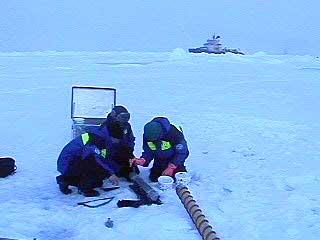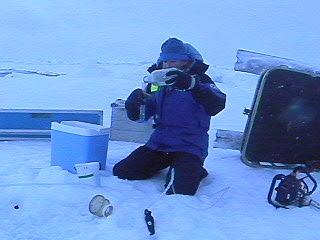
|
|
12 August, 2001
The Iceman Cometh Sunday, 12 August 2001
Hej!
Life on Board
Awakened by my alarm at 6 am, I went downstairs to start preparing
American-style blueberry pancakes for 70. Breakfast is at 7:30. I have 90
minutes. I don't know where anything is in the kitchen and all the boxes
are in Swedish. OK. After I succeeded in rounding up all of the
ingredients (mostly by tasting stuff), I was ready to start mixing. Hmmm.8
cups of flour. This big measuring cup is in deciliters. Oh well, I'll
just guess. 2 Tablespoons of baking powder. Oops, no measuring spoons. A
small handful seems about right. Sugar, salt, baking soda. 8 eggs. Oh
yeah, this one is easy. One quart of buttermilk. Here is a carton of
buttermilk that says 1 Liter. A liter is about a quart, pour in two
cartons. Mix it up, add blueberries until it looks good. Warm up some
syrup. Voila! American blueberry pancakes that everyone loved! (The Chief
Cook even asked for my recipe)
Where Are We Now?
This morning the temperature was -5 Celsius, or 5 below freezing.
Unfortunately, since it had rained all day yesterday, everything on the
decks had a clear coating of slippery ice. It made working on the aft deck
interesting. A half-ton CTD/sampling rosette filled with seawater being
pulled by 6 scientists on a rolling cart then pushed into a container on an
almost frictionless surface at 9 am is asking for disaster. And we almost
did have a disaster. While we were pushing the rosette into the container
shed where we get our water samples, the rolling cart slipped out from
under it when we were transferring the rosette inside. The wheels of the
floor-jack got wedged between the cart and the container, with the weight
of the rosette pressing down. The door is just wide enough for the rosette
so 3 of us were stuck inside the container and 3 were outside. We had to
jack it up with crowbars and blocks of wood that the people outside passed
to us. It took us 45 minutes to free the rosette. Not a good start to the
day. Our position was 88o28' North by 0o44' West.
Scientists at Work
The wind changed direction again, so at 10:30, the ship was turned 180o.
Everyone who wanted to go onto the ice had to be off the ship by 10, or
wait until later. Today was one of our intensive sampling days so we had 7
depths from the CTD/sampling rosette to prepare. I was finished with this
about 12:30 then I got the chance to go out coring with the "Iceman," Tuomo
Roine from Finland. They call him this because he never seems to get cold,
and, he works with ice cores pretty much 24-hours a day. He actually swam
around a bit at the North Pole when people were taking dips in the water
instead of flinging himself back onto the platform screaming like most of
the others. Also joining us on the ice today were Jenny Larsson from the
University of Stockholm, Zoe Fleming from England, and our security officer
Anders Gejer, who drove us and all of the coring equipment out to the
chosen site on the snowmobile.
The ice was about 3 meters thick where we were, so it took quite awhile to
process each core. We also pumped up a brine sample by drilling a hole
about halfway through then letting it sit for a bit. Since ice freezes as
pure H2O, all of the salt in seawater is forced into pockets and channels
between the ice crystals as sea ice forms. This brine, or super-salty
water, will drain into the hole made by the ice corer. We pumped up about
a liter then filtered it to check for chlorophyll, which indicates the
presence of ice algae. Exact volume and temperature were also recorded.
It was still below freezing, windy, and had started to snow by the time we
came in for dinner, with boxes of ice cores to be melted and analyzed.
Vi ses! (See you later!)
From Deck 4 on the Icebreaker Oden, drifting west, north of 88,
Dena Rosenberger

Tuomo, Jenny, and Zoe measure and cut up an ice core

That's me measuring the volume of the brine we collected. Behind me, the sled is turned on its side to block the wind.
Contact the TEA in the field at
.
If you cannot connect through your browser, copy the
TEA's e-mail address in the "To:" line of
your favorite e-mail package.
|
